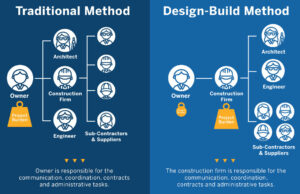These are just some of the lessons we have learned from our most recent government work in the Design Build process.
The Design Build process has advantages and some challenges and understanding the Design Team’s role’s and responsibilities under the contract is critical to project success.
1. Develop a good relationship with your COR/ Government Project Manager. He is the referee of the entire process. Get this person on your side. He is also the only person who can give your design team an Honorable Mention in the DB team rating which will help you win projects down the road.
- Go the extra mile early in the process to show that your firm is professional and looking out for the best interest of the project. When he says jump. You say how high.
- Building up this trust will earn you and your contractor big points that will pay off down the line when there are gray areas in the contract requirements and he trusts you as the design team to deliver the right technical solution for the project.
2. Understand the UFC. The UFC is the United Facilities Criteria. It is in many ways similar to a city’s amendments to the IBC.
- The UFC tells you which codes the USACE etc want to follow for a specific part of the project. For example: IBC for occupancy, but NFPA for life safety.
- The UFC also has special codes for issues like Force Protection, and for special facilities like Childrens Development Centers.
3. If it isn’t in the contract, and it isn’t referenced by the contract. Don’t put it in your drawings.
- In the current competitive environment your Builder has priced the fat out of their bid to get the job. Don’t spend time designing things that aren’t in the contract. They will be identified and eliminated as the budget of your CDs is priced out with subs.
4. Understand the RFP and the proposal when developing your design budget for the project.
- This may go without saying, but there can be some time intensive deliverables that the design team is directly responsible for providing. BIM deliverables, that may or may not be in the platform you are currently using and printing literally hundreds of sets to ship to dozens of locations
5. Leave in a substantial amount of fee for As-Builts if they are required for yourself, and as a hold back from your consultants.
- The Army Corps has a substantial hold back in the Contractors fee for As –Builts. There is a reason for this. They are engineers, and they want good documents to work with and they won’t accept them until they are done to their standards.
- Keeping a healthy portion of your consultants fee for As-Builts is excellent motivation to get close out done right, and quickly at a time when it is easy for your team to have let other projects distract them from the finish line.
6. Look for suppliers who have done government work before to help you with Government submittals.
- Most larger FF&E suppliers (Steelcase, HON etc) understand the government process and are willing to help you develop the document package in order to gain insight into the project they will be bidding.
7. Don’t ask a question until you’ve asked the Contract.
- You will save yourself being asked. “What does the Contract say?”
- You will look substantially smarter when you know the answer right away.
8. Don’t forget that the Proposal is part of the Contract.
- If your team said you were going to use stone instead of tile in the lobby in the proposal, then you are using stone.
9. If you find a savings that gives equal value to the Government then get approval from your contractor and the Government in writing before deviating from the contract or proposal.
- A verbal approval can put you can deep into the design process before a reviewer flags you sending you back to the drawing board despite your good intentions.
10. Be your Builders best ally
- Remember that you are working for the builder.
- Be honest with them when they are having trouble interpreting the contract’s technical requirements. It is much faster if you correct any issues than waiting for the Government to find them.
- Always bring issues to your client before you talk to the Government. The Government understands the process and respects your judgement in delaying answers to consult with your team.
11. Don’t forget your responsibility to the Government.
- If you allow the builder to ignore the contract, then the government has the right to do your job for you, and the government isn’t going to be nearly as responsive or as cooperative as you will be for your contractor.
12. Be responsive to the builder.
- They are working against a hard deadline but need to run technical questions through you. Keeping them working keeps them happy which will come in handy when you need their help, or better when they decide who to use on their next team.









